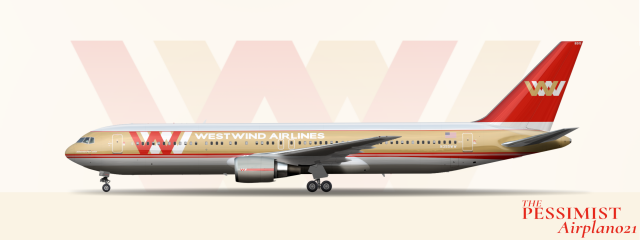
1988 - Boeing 767-300ER
- Owner: ThePessimist (View all images and albums)
- Uploaded: May 24 2023 05:32 PM
- Views: 1,230
- Album Westwind

Slow but measured long haul expansion was an important aspect of Westwind’s so called “Roadmap for the Turn of the Millennium”. A subset of this plan was a substantial expansion of the long-haul fleet. Westwind’s aging DC-10s were joined by an increasingly diverse troupe of Boeing 767 variants. Together with their tri-engined and 757 counterparts, Westwind 767s became a mainstay of many pacific airports. Unlike the carrier’s drive to apply one plane fits most economics to its domestic routes, Westwind management remained convinced that the key to operating a competitive pacific service was having the perfect aircraft. Westwind’s stables of 767 variants ballooned in the late 80s and by the mid-1990s the carrier had 767-200s, 767-200ERs, and 767-300ERs in its roster. This was in addition to the aged but numerous DC-10 variants in the fleet. All 767 variants were named after various manmade “utility landmarks”. For instance, the 767-300ERs were named after lighthouses. N355WW, pictured above, was named Point Pigeon Lighthouse during its years of Westwind service.
Another aspect of the Roadmap was updating Westwind’s brand identity. Even though present management was extremely happy with the logo and livery the airline would sport for over a decade, they recalcitrantly agreed with brand advisors who warned that without an update Westwind would soon be knocking on the door of being a distinctly outdated airline. Thus, a new evolution of the logo was crafted along with a slick modern livery that featured a distinctive yet understated shade of gold-brown along with a signature red-orange. This livery was the last developed at a time where Westwind could afford to aggressively repaint its fleet to maintain a homogenous appearance and so like with liveries before it, its roll out occurred in just over a month. This was behind schedule but only because of an unfortunate incident where a DC-10-30 was impounded in Manila over a dispute where airport authorities announced that they would no longer accept foreign cash as payment and Westwind continued to attempt to pay fees in physical American dollars. With the return of the unfortunate DC-10, City of Provo, after much bickering, it was repainted a full seven days late thus delaying the entire rebranding effort much to the chagrin of certain elements of upper management at Westwind. However, despite this delay the rebrand was largely successful, at least at the start, in changing the way consumer viewed the carrier. The new livery was divisive, even amongst air fans, and picked up a nickname from the lovers and the haters: the Mojave Magnum and Banana Slug Rocket respectively. Whether they liked it or not, aviation enthusiasts would be stuck with the livery for another long stretch until it was finally replaced.
![]()
Glad you like it!
Title: Westwind Airlines: A Critical Analysis of Expansion and Rebranding EffortsIntroduction:The provided passage offers insight into Westwind Airlines' expansion strategy and rebranding efforts during the late 1980s and mid-1990s. This critical analysis will assess the implications of Westwind's long-haul fleet expansion and the effectiveness of its brand identity update. Additionally, it will discuss the challenges faced during the rebranding process and the public reception of the new livery.Expansion of the Long-Haul Fleet:Westwind's approach to expanding its long-haul fleet through the inclusion of Boeing 767 variants appears to align with its overall roadmap for the turn of the millennium. By diversifying its fleet with newer aircraft, Westwind aimed to enhance its competitiveness in the Pacific service market. The company believed that having the "perfect" aircraft was crucial, indicating a commitment to providing a superior travel experience. However, the passage lacks specific details on the benefits or drawbacks of the 767 variants, leaving the reader with limited knowledge regarding their performance and impact on Westwind's operations.The decision to introduce a diverse range of 767 variants, alongside the aging DC-10s, highlights Westwind's intention to cater to various market segments and routes. This strategy allows the airline to adapt to different passenger demands and optimize efficiency. However, without further information on the fleet's performance, maintenance costs, and customer satisfaction, it is challenging to evaluate the success of this expansion effort.Rebranding and Updating Brand Identity:Recognizing the need to modernize its brand identity, Westwind embarked on a rebranding initiative. While management initially expressed contentment with the existing logo and livery, they eventually acknowledged the importance of keeping up with the times. The passage emphasizes the development of a new logo and a contemporary livery featuring gold-brown and red-orange colors. However, it fails to provide a comprehensive understanding of how these changes aligned with the brand's values and customer preferences.An effective rebranding effort involves more than just visual changes. It requires a deep understanding of the target market, brand positioning, and competitive landscape. Without a detailed analysis of Westwind's market research and customer feedback, it is difficult to assess the strategic rationale behind the new logo and livery. Moreover, the passage does not mention whether the brand identity update was accompanied by improvements in service quality, customer experience, or other tangible enhancements that would solidify the airline's position in the market.Challenges Faced during Rebranding:The passage briefly mentions the challenges Westwind encountered during the rebranding process. One major setback was the impoundment of a DC-10-30 in Manila due to a payment dispute, resulting in a delay in the repainting process. This incident not only disrupted the rebranding schedule but also frustrated certain members of the upper management team. However, the passage does not provide sufficient context regarding the financial and operational implications of this delay.A comprehensive analysis of the rebranding challenges would require more information on the extent of the delay's impact. Did it result in financial losses, increased costs, or damage to Westwind's reputation? Additionally, the passage does not mention whether Westwind had contingency plans in place to address unforeseen circumstances during the rebranding process. Proper risk management and proactive measures are essential for successful brand transitions.Public Reception of the New Livery:The passage indicates that the new livery was divisive, earning it two contrasting nicknames from aviation enthusiasts: the "Mojave Magnum" and the "Banana Slug Rocket." While this suggests a wide range of opinions, the passage does not elaborate on the specific reasons behind these reactions. Without further context, it is challenging to evaluate whether the rebranding successfully resonated with Westwind's target audience
Your computer aided experiment is interesting and unique. I think that the robot fails to understand that this single post will eventually become part of a much larger story of Westwind. Further, it would sadly be impossible for me to completely and adequately write in a reasonable and easily digestible format that completely details each piece of the carrier's history. Finally, the robot fails to understand that I leave most of the analysis of the aesthetic appeal of the brand to the viewer - obviously I think the livery is "good" in the sense that it is a realistic representation of what an airline might make given the circumstances around the livery. For me to explain the specific reasons behind positive and negative reactions to the livery would deprive the viewer the opportunity to examine the livery and wonder what 90s air fans might have celebrated and bemoaned on the livery.

 Sign In
Sign In Create Account
Create Account












